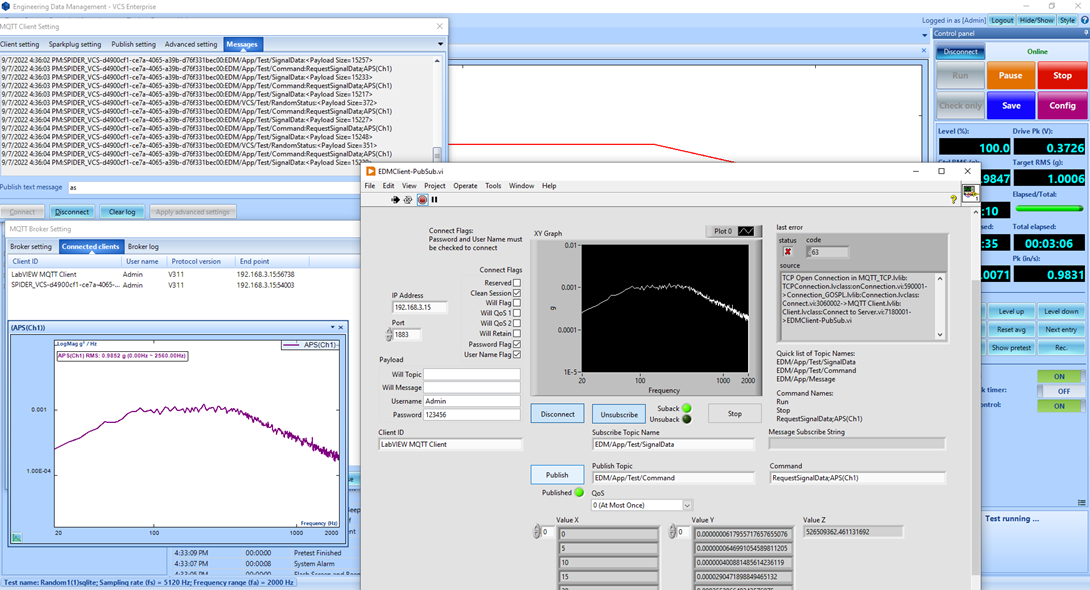Multiple shaker systems are typically used for vibration testing when the unit under test (UUT) is too long or too heavy to test with a single shaker. This approach overcomes the limitations of high drive requirements with a single shaker test. Multiple shaker systems also allow the UUT to be tested in various configurations and directions in the horizontal and vertical orientations.
Read MoreUsers can monitor the status of environmental tests (vibration, temperature, humidity) operating in EDM VCS, measurements taken in EDM DSA, and remotely located tests by implementing MQTT in EDM.
Read MoreImplementing MQTT in EDM allows users to remotely monitor and operate environmental tests (vibration, temperature, humidity) and take measurements using EDM DSA.
Read MoreThe implementation of MQTT in EDM allows users to monitor the status of environmental tests (vibration, temperature, humidity) executed in EDM VCS, measurements taken in EDM DSA, and remotely operate a test.
Read MoreSingle axis vibration control tests are widely used to qualify the behavior of the unit under test (UUT). If the UUT passes the test requirement then it provides confidence about the sustainability and durability of the test structure. However, sometimes excitation in multiple directions is required to test the robustness of the UUT which has led to the wide use of Multiple-Input Multiple-Output (MIMO) testing for the programmed test profiles. It is therefore important to make sure that the hardware setup allows for the unit to be tested in various configurations of single axis, dual axis, or three-axis. However, it takes long hours to manually change the setup because of the components (shaker setup, slip table, driving bar, fixture, etc.) involved.
Read MoreCrystal Instruments EDM 9.0 release introduces new additions to the Spider product line featuring support for sampling rates up to 256 kHz.
The new Spider-80Hi and Spider-80Ci are scalable versions of the Spider system featuring the impressive new 256 kHz sampling rate. Recording can also be performed at sampling rates up to 256 kHz for all input channels, up to 512 channels per Spider system.
The compact, ultra-portable four channel version of the Spider has also been developed to support a 256 kHz sampling rate. Currently, three variations of the compact Spiders supporting the 256 kHz sampling rate are available: Spider-20H, Spider-20HE, Spider-20i.
Read MoreMultiple-Input Multiple-Output (MIMO) vibration testing has increased in popularity as a result of the development of multiple shaker table systems and the availability of MIMO vibration controllers. The readiness of standards such as Mil-STD 810G Method 527 and the IEST DTE 022 Working Group Recommendation have also contributed to the huge momentum MIMO testing has gained in the past decade.
Read MoreMultiple-Input Multiple Output (MIMO) Testing has gained a huge momentum in the past decade with the development of multiple shaker table systems, the availability of MIMO vibration control systems, and the readiness of standards (e.g., MIL-STD 810G Method 527, IEST DTE 022 Working Group Recommendation).
Read MoreEDM’s Account Management program controls the accessibility of features from different users. This provides a structure for managing the privileges for different groups of users. The Account Manager can be used to prevent lower-level users from adjusting parameters or display settings. It also allows users to customize the toolbars for a simplified user interface. By hiding certain features, the UI can be made much easier to use.
Read MoreThe capabilities of Crystal Instruments’ Spider devices are well known and the ability of the Spider to operate without a PC makes it advantageous for several applications, including vibration control.
Read MoreExtracting the natural frequencies, damping shapes, and mode shapes of a structure aids in improving the design of the unit under test. In this case, the modal characteristics of a license plate is acquired by performing a modal analysis.
Read More










